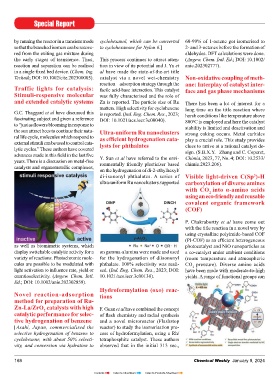Page 168 - CW E-Magazine (9-1-2024)
P. 168
Special Report
by running the reactor in a transient mode cyclohexanol, which can be converted 60-99% of 1-octene got isomerised to
so that the branched isomers can be recove- to cyclohexanone for Nylon 6.] 2- and 3-octenes before the formation of
red from the exiting gas mixture during aldehydes. DFT calculations were done.
the early stages of transience. Thus, This process continues to attract atten- (Angew. Chem. Intl. Ed.; DOI: 10.1002/
reaction and separation can be realised tion in view of its potential and J. Yu et anie.202302777).
in a single fixed bed device. (Chem. Ing. al have made the state-of-the-art title
Technik; DOI: 10.1002/cite.202300005). catalyst via a novel wet-chemistry Non-oxidative coupling of meth-
reaction – adsorption strategy through the ane: Interplay of catalyst inter-
Traffic lights for catalysis: facile acid-base interaction. This catalyst face and gas phase mechanisms
Stimuli-responsive molecular was fully characterised and the role of
and extended catalytic systems Zn is reported. The particle size of Ru There has been a lot of interest for a
matters. High selectivity for cyclohexene long time on the title reaction where
G.C. Thaggard et al have discussed this is reported. (Ind. Eng. Chem. Res., 2023; harsh conditions like temperature above
fascinating subject and given a reference DOI: 10.1021/acs.iecr.3c00040). 800 C is employed and here the catalyst
o
to “just as flowers blooming in response to stability is limited and deactivation and
the sun attract bees to continue their natu- Ultra-uniform Ru nanoclusters strong coking occurs. Metal carbides
ral life cycle, molecules which respond to as efficient hydrogenation cata- play a crucial role. This study provides
external stimuli can be used to control cata- lysts for phthalates clues to arrive at a rational catalyst de-
lytic cycles.” These authors have covered sign. (S.B.X.Y. –Zhang and C. Coperet,
advances made in this field in the last five Y. Sun et al have referred to the envi- Chimia, 2023, 77, No. 4; DOI: 10.2533/
years. There is a discussion on metal-free ronmentally friendly plasticiser based chimia.2023.206).
catalysts and organometallic complexes,
on the hydrogenation of di-2-ethylhexyl/
di-isononyl phthalates. A series of Visible light-driven C(Sp )-H
3
ultra-uniform Ru nanoclusters supported carboxylation of diverse amines
with CO into α-amino acids
2
using an eco-friendly and reusable
covalent organic framework
(COF)
P. Chakrabortty et al have come out
with the title reaction in a novel way by
using crystalline polyimide-based COF
(PI-COF) as an efficient heterogeneous
as well as biomimetic systems, which photocatalyst and NiO nanoparticles as
display switchable catalytic activity for a on gamma-alumina were made and used a co-catalyst under ambient conditions
variety of reactions. Photochromic mole- for the hydrogenation of diisononyl (room temperature and atmospheric
cules are possible to be modulated with phthalate. 100% selectivity was reali- CO pressure). Diverse amino acids
2
light activation to influence rate, yield or sed. (Ind. Eng. Chem. Res., 2023; DOI: have been made with moderate-to-high
enantioselectivity. (Angew. Chem. Intl. 10.1021/acs.iecr.3c00130). yields. A range of functional groups can
Ed.; DOI: 10.1002/anie.202302859).
Hydroformylation (oxo) reac-
Novel reaction-adsorption tions
method for preparation of Ru-
Zn-La/ZrO catalysts with high F. Guan et al have combined the concept
2
catalytic performance for selec- of flash chemistry and radial synthesis
tive hydrogenation of benzene and a novel microreactor (Flashstop
[Asahi, Japan, commercialised the reactor) to study the isomerisation pro-
selective hydrogenation of benzene to cess of hydroformylation, using a Rh/
cyclohexene, with about 50% selecti- tetraphosphite catalyst. These authors
vity, and conversion via hydration to observed that in the initial 313 sec.,
168 Chemical Weekly January 9, 2024
Contents Index to Advertisers Index to Products Advertised

